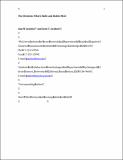| dc.contributor.author | Grafton, Scott T. | |
| dc.contributor.author | Graybiel, Ann M | |
| dc.date.accessioned | 2017-01-31T16:30:13Z | |
| dc.date.available | 2017-01-31T16:30:13Z | |
| dc.date.issued | 2015 | |
| dc.identifier.issn | 1943-0264 | |
| dc.identifier.uri | http://hdl.handle.net/1721.1/106805 | |
| dc.description.abstract | After more than a century of work concentrating on the motor functions of the basal ganglia, new ideas have emerged, suggesting that the basal ganglia also have major functions in relation to learning habits and acquiring motor skills. We review the evidence supporting the role of the striatum in optimizing behavior by refining action selection and in shaping habits and skills as a modulator of motor repertoires. These findings challenge the notion that striatal learning processes are limited to the motor domain. The learning mechanisms supported by striatal circuitry generalize to other domains, including cognitive skills and emotion-related patterns of action. | en_US |
| dc.description.sponsorship | National Institutes of Health (U.S.) (NIH Grant R01 EY012848) | en_US |
| dc.description.sponsorship | National Institutes of Health (U.S.) (NIH Grant R01 NS025529) | en_US |
| dc.description.sponsorship | National Institutes of Health (U.S.) (NIH Grant R01 MH060379) | en_US |
| dc.description.sponsorship | United States. Office of Naval Research (ONR Grant N00014-07-1-0903) | en_US |
| dc.description.sponsorship | United States. Public Health Service (Grant NS44393) | en_US |
| dc.description.sponsorship | United States. Army Research Office (ARO Contract No. W911NF09-D-0001) | en_US |
| dc.language.iso | en_US | |
| dc.publisher | Cold Spring Harbor Laboratory Press | en_US |
| dc.relation.isversionof | http://dx.doi.org/10.1101/cshperspect.a021691 | en_US |
| dc.rights | Creative Commons Attribution-Noncommercial-Share Alike | en_US |
| dc.rights.uri | http://creativecommons.org/licenses/by-nc-sa/4.0/ | en_US |
| dc.source | Prof. Graybiel via Courtney Crummett | en_US |
| dc.title | The Striatum: Where Skills and Habits Meet | en_US |
| dc.type | Article | en_US |
| dc.identifier.citation | Graybiel, Ann M., and Scott T. Grafton. "The Striatum: Where Skills and Habits Meet." Cold Spring Harbor Perspectives in Biology 2015;7: a02169. | en_US |
| dc.contributor.department | Massachusetts Institute of Technology. Department of Brain and Cognitive Sciences | en_US |
| dc.contributor.department | McGovern Institute for Brain Research at MIT | en_US |
| dc.contributor.approver | Graybiel, Ann M | en_US |
| dc.contributor.mitauthor | Graybiel, Ann M | |
| dc.relation.journal | Cold Spring Harbor Perspectives in Biology | en_US |
| dc.eprint.version | Author's final manuscript | en_US |
| dc.type.uri | http://purl.org/eprint/type/JournalArticle | en_US |
| eprint.status | http://purl.org/eprint/status/PeerReviewed | en_US |
| dspace.orderedauthors | Graybiel, Ann M.; Grafton, Scott T. | en_US |
| dspace.embargo.terms | N | en_US |
| dc.identifier.orcid | https://orcid.org/0000-0002-4326-7720 | |
| mit.license | OPEN_ACCESS_POLICY | en_US |
| mit.metadata.status | Complete | |
